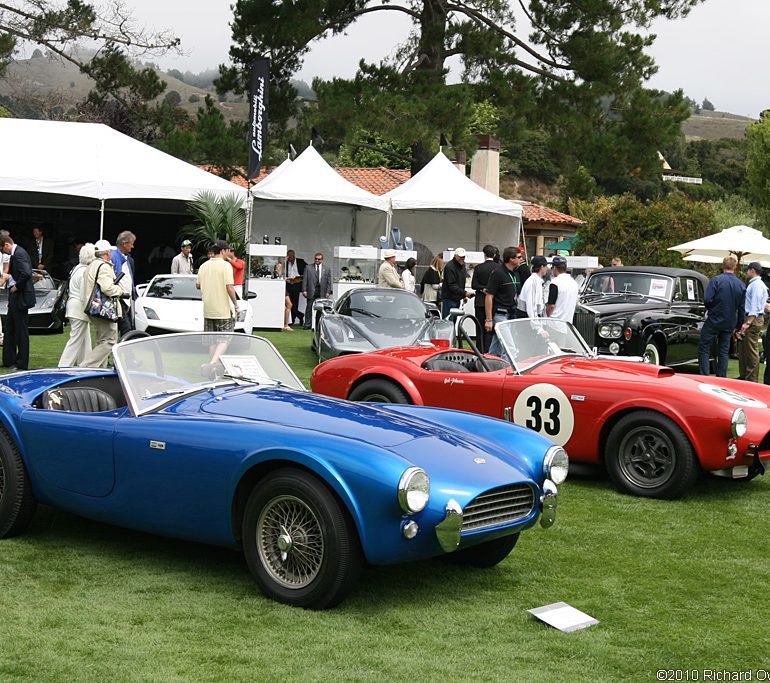1962 AC-Shelby Cobra Prototype
The Shelby Cobra story begins with this car which was first assembled by AC Cars in Thames Ditton, England. It’s the very first Cobra and one of the most important individual cars in American sports car history. Fortunately, Shelby retained the car which appeared at numerous show and in numerous magazines in support of the Shelby and Ford brands.
Shelby began by visiting the the Hurlock family in England who were successfully manufacturing the indispensable Ace and Aceca. Shelby recalls “I went to AC Cars in about June 1961. I’d looked at several other chassis situations for building my own cars, including AC’s Ace. Ray Brock came to me about the same time and said, ‘Ford has a new small-block V-8. 221 inches.’”1 Not long afterward he was in Detroit to meet with Dave Evans, Don Frey and Lee Iacocca. He recalls “I told him that I had a chassis, and that, if I could get these Ford engines, I thought I could build a car that would blow off the Corvette. I needed to borrow $25,000 to build two cars, plus engines. Iacocca agreed.”1
Putting an American V8 in a well-used european chassis such as a Ferrari or Maserati was common in racing, but Shelby was the first to market a working a sports car with official factory backing. Furthermore, many of the V8-powered specials in SCCA racing had started achieved success over the much more expensive European marques. With the Cobra, Shelby saw a new opportunity.
After Shelby’s visit to AC, they agreed to ship a version of their Ace platform to America without an engine. All the initial development of the chassis was done by AC who fitted the first prototype with the 221 in³ Ford V8. Like the production cars to the follow, this first car was eventually shipped to America.
In February of 1962, CSX2000 sometimes known as CSX0001 was completed in Dean Moon’s shop in Santa Fe Springs, California. When it reach Shelby, one of Ford’s first 260 in³ engines was available, which at the time was an upcoming racing engine developed with joint co-operation with Holman & Moody. Not long after arriving, the brushed-aluminum car was outfitted with a 260 and christened a Shelby.
Shelby gives little credit to AC. He commented “We strengthened the chassis tubes, we had to put different spindles and hub carriers on it, we had to put a different rearend in it,” recalls Shelby. “We changed those old buggy springs…there were very few nuts and bolts in that car that were the same nuts and bolts as in an AC Ace.”
Not long after completion it was given to Sports Car Graphic’s editor for a cover feature that appeared later in their May 1962 issue. He described it as “one of the most impressive production sports cars we’ve ever driven. Its acceleration…can only be described as explosive and at least equal to that of the better running hot Corvettes and Berlinettas we’ve driven.”2.
Not long thereafter it was painted metallic yellow/gold by Dean Jeffries for its international debut at the 1962 New York Auto Show. Naturally it was a great success for Shelby and Ford who recieved more than orders and both green-lighted production. Pete Brock said “Carroll could have taken 500 orders at that time, but he took only enough to get the thing off the ground. The people from Ford were there, and everybody was enthusiastic, so they said, ‘Okay. Let’s do it.'”
After an agreement was reached with both AC and Ford, the Cobra became available for sale at all Ford dealers with official ‘Powered by Ford’ emblems. The prototype went on to serve as extensive press duty which included multiple paint jobs from metallic yellow, to red and blue.
Being the first Cobra, it was numerous detail differences from the production Cobras including a unique front ‘A.C. Shelby Cobra’ badge. The list of unique details include the dashboard layout, front bumpers, seats, lights and panel contours. Despite being somewhat unique CSX2000 was used by the FIA to qualify the Cobra as a production car.
By the fall on 1962 the prototype had done its job and Cobra production was in full swing. By this time the second car, CSX2002, was already beating Corvettes on the racetrack. Shelby had to sense to personally retain the first Cobra which has always remained in his possession. Unlike Ferrari which would turn such a car into a development hack, Shelby kept the car as it was originally built.
In the late 2000s, Motor Trend convinced Shelby to drive the car and he commented “Felt just like it did nearly forty years ago, same tires, same wheels, same old 260 engine. Doesn’t handle all that bad, you know? And runs pretty good, for what it is. It felt just like when John Christy and I used to take it out and look for Corvettes when we first built it.”
In Detail
| type | Concept / Prototype Car |
| production | 1 |
| engine | Ford 90 Degree V8 |
| position | Front Longitudinal |
| aspiration | Natural |
| valvetrain | Pushrod OHV, @ Valves per Cyl |
| displacement | 4261 cc / 260 in³ |
| body / frame | RWD w/Salisbury LSD |
| front brakes | Discs |
| rear brakes | Discs |
| f suspension | Wishbones w/Coil Springs & Dampers |
| r suspension | Wishbones w/Coil Springs & Dampers |
| wheelbase | 2290 mm / 90.2 in |
| front track | 1380 mm / 54.3 in |
| rear track | 1370 mm / 53.9 in |
| transmission | 4-Speed Manual |
| top speed | ~217.3 kph / 135 mph |
| 0 – 60 mph | ~5.5 seconds |





